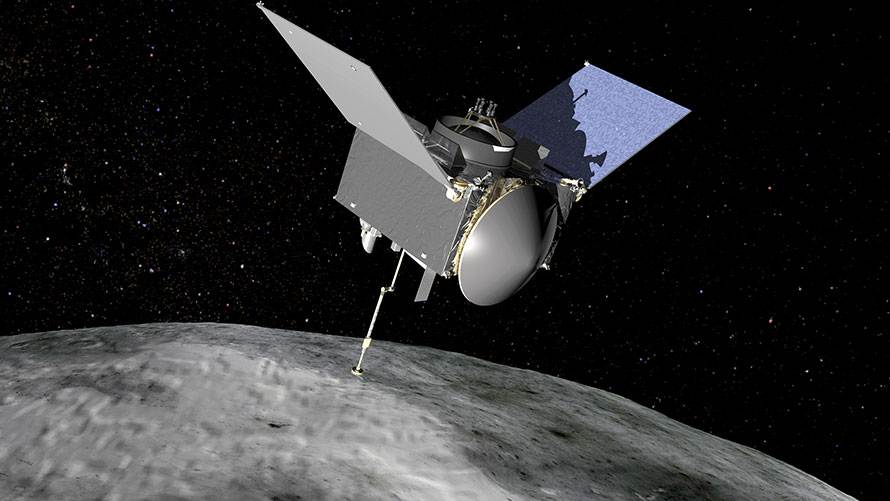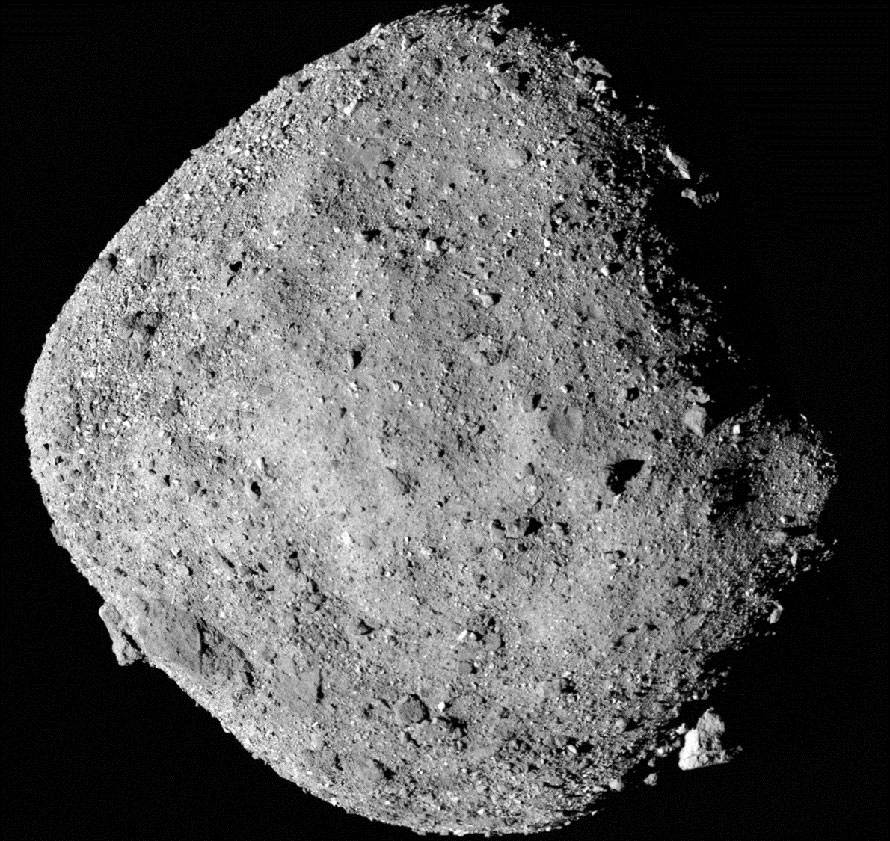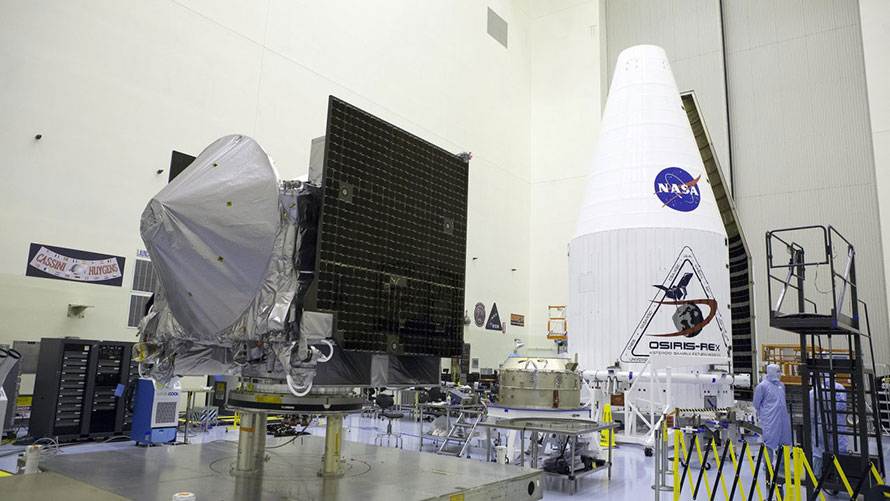By Trevor J. Mills
OSIRIS-REx has just entered orbit around asteroid Bennu on New Year’s Eve, 2018.
The Origins, Spectral Interpretation, Resource Identification, Security-Regolith Explorer (OSIRIS-REx) spacecraft is an asteroid sample return mission, similar to the Japan Aerospace Exploration Agency’s Hayabusa2. OSIRIS-REx’s name defines both its mission and its capabilities.
- ‘Origins’ – the return and analysis of a sample of a pristine carbon-rich asteroid to study the nature, history, and distribution of the asteroid’s minerals and organic material.
- ‘Spectral Interpretation’ – the global properties of a primitive carbon-rich asteroid to allow for direct comparison with existing ground-based telescopic data for all asteroids.
- ‘Resource Identification’ – the goal of mapping the global properties, chemistry, mineralogy of a primitive carbon-rich asteroid to define its geologic and dynamic history and provide context for the returned sample.
- ‘Security’ – measuring the Yarkovsky Effect on the asteroid and learn which asteroid properties contribute to the effect.
- ‘Regolith Explorer’ – documenting the texture, morphology, geochemistry, and spectral properties of the regolith (surface material) at the sampling site.
Asteroid Bennu was selected for this mission because of its composition, size, and proximity to Earth. Bennu is a rare B-type asteroid (primitive and carbon-rich) and is expected to have organic compounds and water-bearing minerals. B-type asteroids have not significantly changed since they formed 4.5 billion years ago. In comparison, Hayabusa2’s target, Ryugu, is a C-type carbonaceous asteroid which are the most common type in the solar system. Bennu is ~500 m in equatorial diameter, ~510 m in polar diameter, it has a 4.3 hours rotational period, a 1.2-year orbital period, a 6-degree orbital inclination, and comes close to Earth every 6 years.
 OSIRIS-REx Spacecraft at Bennu (artist concept). Image: NASA Goddard Space Flight Center.
OSIRIS-REx Spacecraft at Bennu (artist concept). Image: NASA Goddard Space Flight Center.
OSIRIS-REx was launched from Earth on 8 September 2016 on an Atlas V rocket from Cape Canaveral, Florida. It then entered a cruise phase after successfully deploying its solar panels, initiating its propulsion system, and establishing a communication link with Earth. On 3-4 December 2018, OSIRIS-REx matched the speed (~63,000 mph) and orbit of Bennu at roughly 19 km away from the asteroid. It entered Bennu’s orbit on December 31, 2018, and will start a remote sensing campaign used to select a sample site. After a sample site is selected, OSIRIS-REx will move into position to collect a sample of Bennu’s surface material. OSIRIS-REx can make up to three attempts using the TAGSAM to collect >60 grams of material. Around March 2021, the spacecraft will depart Bennu for the return trip back to Earth. OSIRIS-REx is then scheduled to land in the United States Air Force’s Utah Test and Training Range in late September 2023.
OSIRIS-REx has several instruments onboard supporting its mission. Some of the instruments are:
- The High Gain Antenna provides communications between the spacecraft and Earth ground systems.
- The OSIRIS-REx Laser Altimeter provides ranging data, global topographic mapping, and local topographic mapping of candidate sample sites.
- The guidance, navigation, and control LIDAR provides information about the spacecraft’s range to Bennu’s surface, to ensure that the spacecraft maintains a safe distance from Bennu.
- The NavCams, or Navigation Cameras, are part of the guidance, navigation, and control system on OSIRIS-REx. They are used for optical navigation of the spacecraft.
- The Sample Return Capsule is designed to hold and return the sample of Bennu’s regolith to Earth.
- The Touch-And-Go Sample Acquisition Mechanism (TAGSAM) is an elegantly simple sampler head with an articulated arm. It is designed to collect a sample from the surface of Bennu.
- The Visible and Infrared Spectrometer (OVIRS) produces mineral and organic spectral maps and gathers local spectral information of candidate sample sites in near-infrared.
- Thermal Emission Spectrometer (OTES) produces mineral and thermal emission spectral maps, and local spectral information of candidate sample sites.
Data obtained from OSIRIS-REx’s two spectrometers, OVIRS and OTES, have already found the presence of hydroxyl molecules, which contain oxygen and hydrogen atoms bonded together. An analysis of the data suggests these hydroxyl groups exist across the asteroid in water-bearing clay minerals. This implies that at some point in the asteroid’s life it interacted with water, which may have been sourced from Bennu’s parent body, a much larger asteroid. Such water-bearing clay may be an important resource for future asteroid miners and space settlers.
 Mosaic image of asteroid Bennu taken by OSIRIS-REx from a range of 15 miles on December 2, 2018.
Mosaic image of asteroid Bennu taken by OSIRIS-REx from a range of 15 miles on December 2, 2018.
Image: NASA/Goddard/University of Arizona.
Ultimately, OSIRIS-REx’s mission is important in understanding our origins, future Earth asteroid protection missions, and will further our ability to exploit solar system resources.
For example, Bennu may contain the molecular precursors to the origin of life and the Earth’s oceans. Additionally, Bennu is potentially one of the most hazardous asteroids, as it has a relatively high probability of impacting the Earth late in the 22nd century. Instruments onboard OSIRIS-REx will determine Bennu’s physical and chemical properties, which will be critical if we (the Earth) ever need to undertake an asteroid impact mitigation mission. Finally, asteroids like Bennu contain natural resources such as water, organics, and precious metals. In the future, these asteroids may fuel the exploration of the solar system by robotic and manned spacecraft.



















